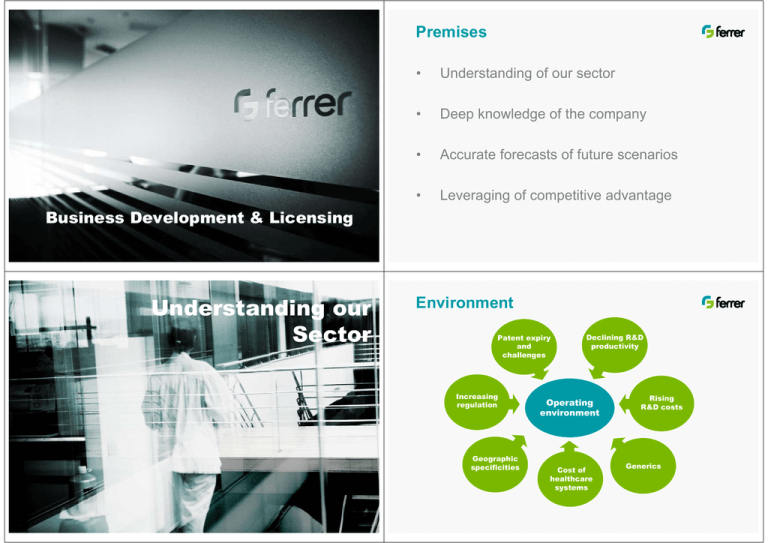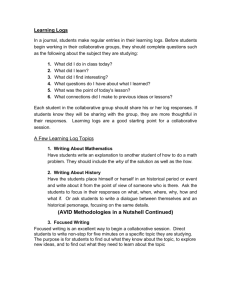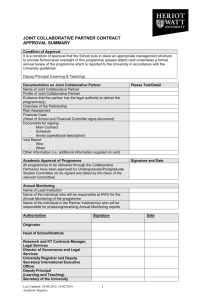Premises
advertisement

Premises • Understanding of our sector • Deep knowledge of the company • Accurate forecasts of future scenarios • Leveraging of competitive advantage Business Development & Licensing Understanding our Sector Environment Patent expiry and challenges Declining R&D productivity ` Increasing regulation Geographic specificities Operating environment Cost of healthcare systems Rising R&D costs Generics Trends Globalization Emerging markets Megamergers & Acquisitions Commoditization Shift to biotech New technologies Demographic changes Quality of life Facts Facts By 2016, research-based pharma stands to lose around $140 billion in annual sales through loss of patent protection Drugs are coming off patent faster than the pharma companies can replace them However, worldwide sales of pharmaceuticals will increase to $1.3 trillion by 2020, driven by: aging populations & related illnesses surge in demand from emerging markets Facts Demography: Aged 60+ 2002 Demography: Aged 60+ 2050 The healthcare model of the future: personalized medicine (I) The healthcare model of the future: personalized medicine (II) Current Model – “one size fits all” – Blockbuster oriented Current Model Illness Symptombased diagnosis Recover and visit Treatment Costly Could it be more effective? Most drugs only work in 1/3 of patients Drug side effects are one leading cause of death The healthcare model of the future: personalized medicine (III) Monitoring and prevention Diagnosis Treatment selection Treatment Better patient outcomes Safer treatments More cost-effective healthcare Aims to provide the right diagnosis leading to prevention or tailored treatments (the right drug at the right dose to the right patient) at the right time. New Technologies Future Model Genetic predisposition Stratified population Future Model – “personalized medicine”- Chipbusters Treatment monitoring Increase efficiency of healthcare delivery and reduce healthcare costs Deep knowledge of the company A strategy for change • • • • • • • Commitment to R&D Vertical integration Diversification Targeted internationalization Partnering & alliances Public-private partnerships HR priorities in tune with the strategy A strategy for change • • • • • Smart sizing Streamlining and strategic resource management Networking and partnering with stakeholders Share-of-voice through new marketing models Re-evaluating supply chain Role of licensing & Business Development Basic Role Basic Role Search, identification and analysis of business opportunities according to: The company’s strategy The company’s objectives Exploratory Purely opportunistic Negotiation and execution of agreements Why? When? What? Framework How? Strategic (new business area, new territory, new technology...) Operative (volume, synergistic fit, punctual or short term needs...) Internal and external management Why do we need active L&BD? Process External inputs An increasingly Global Collaborative Environment An increasingly competitive environtment Open Innovation is being introduced in most MANAGE Alliance management GET companies as a way of increasing productivity Approve / Execute Internal inputs FIND Is internal R&D productivity and efficiency enough? Critical evaluation of added value projects in our Connect R&D Ability to fulfill commercial needs WANT Align Process What do we look for MANAGE Connect Align Alliance management Classical Scouting. To initially agree: GET Approve / Execute Personal Networking. Areas of interest Domestic & International events. FIND WANT Stage of development Connect Active communication/spreading of our policy/interests (internal & external). Size To review them every 12 months. Align What do we look for Projects yielding high added value products What do we look for Available Opportunities Market What is needed? Define Main Strategic Areas Other Areas of Interest What is available? Technology Market What is needed? What is possible? What fits our strategy and capabilities ? What fits our strategy? Preferred Technological Platforms want to also explore OPPORTUNITIES? Business Model Business Model Collaborative Innovation improves the room and the likelihood Evaluation Criteria Characteristics of the project Process Management Environment Innovation Entrance Barriers Added Value Lobbying Value Chain Competence Evaluation and Negotiation Process Management Approval/Execution Internal coordination: Define requirements according to characteristics of the given project (type of R&D, Clinical, Regulatory analysis and type of documents) Commercial Define Area Directors involved in the Finance Differential know-how Socio-economic and political Lead and manage negotiation process environment Business Analysis Commercial evaluation Resources (human, technology, finance) Time Cost of opportunity Synergistic Fit Risk/benefit Domestic Market approval process Establish timelines for approval Ensure quick decision pathways International Markets (mature, emergent) Alliance Management Alliance Management The format of the partnership has to be chosen according to the goal of the project. There is no one-size-fits-all solution Alliance Management Alliance Management It is Critical to have the“right” Steering Committee • Joint Steering Committee needs to be small, strong and objective. • Changing direction or refocussing projects where there is significant “emotional investment” is difficult. Critical structures (able to work behind the scenes): The Steering Committees (R&D, Regulatory, Commercial) The Project Managers (Alliance Managers) It is Critical to have the“right” Alliance Managers: • Effective Alliance Managers needed to act as facilitators and mediators. • The “human” element, the soft skills, the intangible are here “key” for success. • A valuable previous experience is a key point to introduce criteria and trust. The Role of Licensing & BD: R&D The Role of Licensing & BD: R&D Risk minimization and diversification High attrition rates Stricter regulatory requirements Declining productivity Rising costs and longer timelines Clear added value Cutting edge projects Lifecycle management In-house projects on expertise areas R&D PPPs & other collaborations Evidence based personalized medicine Basic care More compelling value proposition Add to workload and costs Need to integrate new technologies Tougher barriers to full approval Integration of emerging technologies Core pharmaceutical knowhow Role of BD Collaborative Innovation Life Cycle Management Line extensions /Short term projects A Global Collaborative Environment A Global Collaborative Environment Collaborative R&D: not a brand new concept... In 1996… 20% During the late 19th and the early part of the 20th, practically all research had 15% been conducted outsourced 10% In 2011… “True innovation does not occur within pharma companies” 5% Golden age of R&D corporate labs 0% 1900 1920 Source: EIRMA 1940 “World’s top pharmaceutical companies do not provide research environment that is specially conductive to originality, lateral thinking and high productivity” Jürgen Drews Hoffmann-La Roche International Research Division, Former President 1960 1980 2000 Paul Isherwood GlaxoSmithKline Director of Innovation A Global Collaborative Environment 1985 1975 1995 2005 A Global Collaborative Environment 2015 1985 1975 1995 2005 2015… Increasingly fragmented value chain DISCOVERY INDUSTRY ACADEMIA A Global Collaborative Environment A Global Collaborative Environment The number of alliances confirms the new scenario Alliances / year Merck: More than 300 alliances in 6 years 500% increase in 7 years Distribution by Stage at Signing for Alliances Late Stage Approved Phase III Phase II 270 197 151 Mid Stage Phase I Preclinical 107 191 Early stage Lead molec. 76 Discovery 832 Source: Deloitte Recap LLC A Global Collaborative Environment External origin of R&D projects in a sample of the Top-25 companies Our Experience: Co-development Projects Our Results: Licensing in 2010 In development 2010 • • • • • • Prescription products: 5 • Nutritional suppl: 2 • Biotechnology: 1 Æone launched product Prescription products: 8 Hospital products: 2 Diagnostics: 1 OTCs: 2 Dermocosmetics: 4




